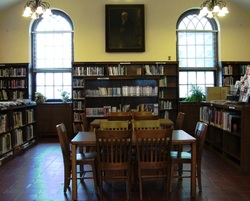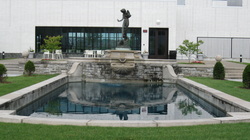The Canajoharie Library

The Canajoharie Library was born in the 1880s when a committee of local dignitaries organized a lending library in the drawing room of the Arkell home. By the early 1900s the library had moved first to a school room and then to rented space downtown. In 1914, under the sponsorship of local industrialist Bartlett Arkell, the library was granted its charter by New York State.
Mr. Arkell's interest in the library grew over the next 10 years, and in 1925 he had the original section of the current facility built, and presented it to the village in memory of his father, state Senator James Arkell. Mr. Arkell continued to be involved in library activities until his death in the 1940s. An endowment that he originated remains an important source of income for the library.
A major addition to the Arkell Museum and Canajoharie Library was completed in 2007 through the generosity of the Arkell Hall Foundation. The Foundation remains an important partner in our shared mission of providing educational and cultural opportunities in our community.
Mr. Arkell's interest in the library grew over the next 10 years, and in 1925 he had the original section of the current facility built, and presented it to the village in memory of his father, state Senator James Arkell. Mr. Arkell continued to be involved in library activities until his death in the 1940s. An endowment that he originated remains an important source of income for the library.
A major addition to the Arkell Museum and Canajoharie Library was completed in 2007 through the generosity of the Arkell Hall Foundation. The Foundation remains an important partner in our shared mission of providing educational and cultural opportunities in our community.
The Memorial Garden

The Memorial Garden was conceived by Mr. Arkell in 1929. The garden was planned by Bartlett and his wife, Louisanna Grigsby Arkell, for a vacant lot between the library and the neighboring Lutheran Church. Mrs. Arkell passed away while the garden was in development, and Mr. Arkell dedicated the finished garden to her memory.
The garden consists of formal barberry hedges, evergreens and flowering shrubs that frame a fountain and reflecting pool. The centerpiece of the fountain is a 7 foot bronze sculpture of a woman by Harriett Frishmuth titled "Humoresque".
The garden consists of formal barberry hedges, evergreens and flowering shrubs that frame a fountain and reflecting pool. The centerpiece of the fountain is a 7 foot bronze sculpture of a woman by Harriett Frishmuth titled "Humoresque".
Earliest history of the Library
Info furnished by Mrs. W.H. Bain, 1924 Article printed in unknown paper, Local History files-Canajoharie Library
"Early in 1884 the Rev. F.S. Haines, a Princeton graduate, becames pastor of the Reformed Church of Canajoharie. Coming from a cultured family his attitude seemed that of one who found Canajoharie unprogressive and ignorant. Possibly this may have been the condition at that time as the Canajoharie High School had been established only eight years.
Mr. Haines asked a few ladies to meet with him to form a committee to try to establish a library. This committee consisted of Mr. Haines, Mrs. Jennie Smith, Mrs. W.J. Arkell, Miss M.Therese Sterling and Miss L. Katharine Smith (now Mrs. W.H. Bain). Mr. Harvey R. Stafford was later added to this committee.
Through local papers contributions of one book from each one interested were asked to form the nucleus of this library. The books so contributed were assembled at the home of Mrs. W.J. Arkell where theywere examined, properly marked and covered with strong paper. Miss Sterling acted as librarian.
To finance this proposition it was decided to solicit members who were each to pay one dollar per year and be entitled to draw one book only at a time, the number of members approximating one hundred. The money thus obtained was supplemented by proceeds of entertainments of various kinds.
Very shortly thereafter Mr. Haines accepted a call to another church and Miss M. Therese Sterling, who had taken an active interest, was recognized as the leader.
The trustees of the High School donated the use of a room in the school building which was known as "the library" for several years.
Miss Sterling removed to Utica and her sister Mrs. Hiram W. Hall, became the active head of the library until she removed from Canajoharie, after which the membership dwindled and interest wained. During the administration of Mrs. Hall, Mrs. Anna M. Fox acted as librarian without compensation and has been the librarian continuously since, a period of nearly thirty years.
Finally, in 1904, the school trustees served notice that the library would have to be removed from the school building or given over to the school, which action prompted Mrs. Martin L. Smith, always interested in good reading, to call a meeting at her home of all interested in saving the library. Five people only responded to this call, Mrs. Anna M. Fox, Mrs. M.M. Sholl, Mrs. Willet F. Cook, Mrs. Elmer J. Finehout and Mrs. William H. Bain. These five ladies, with Miss Mabel W. Smith, reorganized, took over the library, and became the first five trustees of the Association.
In 1914 the trustees applied to the Regents of the State of New York for a charter which was granted and thereby the Canajoharie Library of today came into existence. Mr. Bartlett Arkell's voluntary offer substantial assistance in a financial way was the incentive for making the application.
At the death of Mrs. Cook, Mrs. Bertelle Arkell Barbour was elected a trustee in her place. Later, at the suggestion of the Regents of the State of New York, because of her being a librarian, Mrs. Fox re-signed as a trustee and Mrs. William C. Arkell was elected to fill the vacancy. In 1923 Mrs. Arthur C. Sticht was elected a trustee in place of Mrs. Finehout.
Mr. Arkell has continued to give generous financial aid each year as have also Mr. and Mrs. F.E. Barbour."
"Early in 1884 the Rev. F.S. Haines, a Princeton graduate, becames pastor of the Reformed Church of Canajoharie. Coming from a cultured family his attitude seemed that of one who found Canajoharie unprogressive and ignorant. Possibly this may have been the condition at that time as the Canajoharie High School had been established only eight years.
Mr. Haines asked a few ladies to meet with him to form a committee to try to establish a library. This committee consisted of Mr. Haines, Mrs. Jennie Smith, Mrs. W.J. Arkell, Miss M.Therese Sterling and Miss L. Katharine Smith (now Mrs. W.H. Bain). Mr. Harvey R. Stafford was later added to this committee.
Through local papers contributions of one book from each one interested were asked to form the nucleus of this library. The books so contributed were assembled at the home of Mrs. W.J. Arkell where theywere examined, properly marked and covered with strong paper. Miss Sterling acted as librarian.
To finance this proposition it was decided to solicit members who were each to pay one dollar per year and be entitled to draw one book only at a time, the number of members approximating one hundred. The money thus obtained was supplemented by proceeds of entertainments of various kinds.
Very shortly thereafter Mr. Haines accepted a call to another church and Miss M. Therese Sterling, who had taken an active interest, was recognized as the leader.
The trustees of the High School donated the use of a room in the school building which was known as "the library" for several years.
Miss Sterling removed to Utica and her sister Mrs. Hiram W. Hall, became the active head of the library until she removed from Canajoharie, after which the membership dwindled and interest wained. During the administration of Mrs. Hall, Mrs. Anna M. Fox acted as librarian without compensation and has been the librarian continuously since, a period of nearly thirty years.
Finally, in 1904, the school trustees served notice that the library would have to be removed from the school building or given over to the school, which action prompted Mrs. Martin L. Smith, always interested in good reading, to call a meeting at her home of all interested in saving the library. Five people only responded to this call, Mrs. Anna M. Fox, Mrs. M.M. Sholl, Mrs. Willet F. Cook, Mrs. Elmer J. Finehout and Mrs. William H. Bain. These five ladies, with Miss Mabel W. Smith, reorganized, took over the library, and became the first five trustees of the Association.
In 1914 the trustees applied to the Regents of the State of New York for a charter which was granted and thereby the Canajoharie Library of today came into existence. Mr. Bartlett Arkell's voluntary offer substantial assistance in a financial way was the incentive for making the application.
At the death of Mrs. Cook, Mrs. Bertelle Arkell Barbour was elected a trustee in her place. Later, at the suggestion of the Regents of the State of New York, because of her being a librarian, Mrs. Fox re-signed as a trustee and Mrs. William C. Arkell was elected to fill the vacancy. In 1923 Mrs. Arthur C. Sticht was elected a trustee in place of Mrs. Finehout.
Mr. Arkell has continued to give generous financial aid each year as have also Mr. and Mrs. F.E. Barbour."
